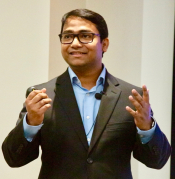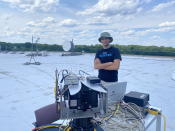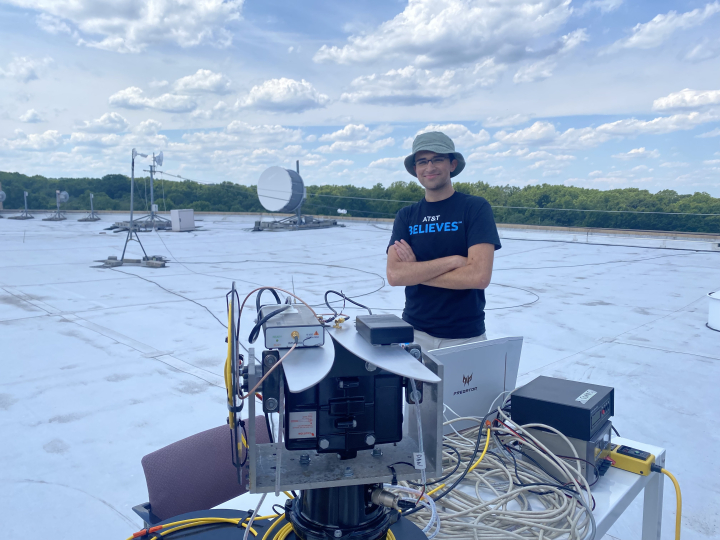UMD Computer Scientists Design Innovative Drone System for Disaster Recovery
It’s estimated that natural disasters cause an average of 45,000 deaths every year globally. The deadliest events are usually low-frequency yet high-impact events such as earthquakes and tsunamis, which can push fatalities to tens or hundreds of thousands. Often, these fatalities are compounded by missing people who are displaced or blocked by damaged infrastructure.
While these disasters are not preventable, high losses in human life may be.
 University of Maryland Assistant Professor of Computer Science Nirupam Roy and senior computer science major Neil Sorkin teamed up to improve current disaster recovery technologies and save more lives. Together, Sorkin and Roy designed a drone system that can help firefighters, first responders and other disaster management services locate people who need help during or after a natural disaster.
University of Maryland Assistant Professor of Computer Science Nirupam Roy and senior computer science major Neil Sorkin teamed up to improve current disaster recovery technologies and save more lives. Together, Sorkin and Roy designed a drone system that can help firefighters, first responders and other disaster management services locate people who need help during or after a natural disaster.
“Imagine that a building has collapsed and people are trapped inside. There are piles of debris blocking their way out, but not the radiofrequency waves emitting from their phones,” Roy said. “Neil and I focused on this point. We all hold phones in our pockets and carry them everywhere, which means that being able to track RF waves somehow will also help us find the people carrying the devices emitting them.”
Potentially both low-cost and resource-efficient, the system quickly detects radiofrequency (RF) waves given off by mobile telecommunication devices and relays information about those wave sources back to the drone operators. In the context of a natural disaster, being able to rapidly identify the general location of an RF source—such as a smartphone—can be a matter of life or death.
“We can do this with any RF source, including wireless networks and walkie-talkies,” Sorkin explained. “It just takes at least two small drones placed in different locations and bearing lines, or the angles between the primary compass directions. Each drone will point in the direction of the RF source from its respective location. Using our system, we can calculate the intersection of these two directions and that’s where the RF-emitting device should be.”
Developing a different kind of drone
The idea for this project began in summer 2022 when Sorkin interned at AT&T and worked on a cellular signal-finding robot that helps boost mobile hotspots in remote or rural areas where cell signals are often weaker than in urban hubs.
 “The robot finds the best direction to point an antenna toward in order to maximize signal strength,” Sorkin explained. “As I was working on it, I realized that there were many other problems that this type of technology could potentially solve.”
“The robot finds the best direction to point an antenna toward in order to maximize signal strength,” Sorkin explained. “As I was working on it, I realized that there were many other problems that this type of technology could potentially solve.”
Sorkin brought his ideas to Roy, whose research lies in the intersection of the technologies needed to build this type of geolocation device: networking, mobility, sensing and localization.
“Professor Roy seemed like the most aligned to my own goals in terms of radio frequency research,” Sorkin said. “His lab is also very active and has many papers associated with developing direction-finding systems using RF and audio.”
With Roy’s research guidance and experience developing SIRIUS (a low-power sensor network capable of communicating directional codes to any received signal), the two sketched out a drone system capable of quickly scanning potentially hazardous environments for cell phone signals.
Sorkin and Roy dubbed their creation ‘RF Trooper,’ a reference to the troopers in the Star Wars franchise. But they still needed to resolve some challenges.
“It’s an onion-peeling problem because the devil lies in the details—how can a tiny drone hold onto a big battery pack? How can it travel an appropriate distance while on limited power? There were various practical limitations that we had to consider,” Roy explained. “Size, weight, power and even financial costs in developing these kinds of systems are problems that any engineer or scientist will encounter.”
Sorkin added, “Each device would’ve taken tens of thousands of dollars to produce, making it insanely difficult to scale the way we want it to. We had to ask ourselves if it was possible to develop sensing mechanisms that are super lightweight, use only a few milliwatts of power but still capable of identifying signal source locations.”
The solution they eventually arrived at was simple: stitching together multiple perspectives taken from the deployed drones, instead of relying on drones constantly scanning in synchrony to find the direction of a cell signal. Sorkin and Roy decided to equip their drones with special directional antennae capable of covering a wide range of RF frequencies, including the frequencies that 4G and 5G cell phones operate on. Much like how a person can hear a sound in their left or right ear and tell which way the sound came from, drones with these antennae were able to decipher the general direction of signal sources. Through this technique, the system could learn both its own location with reference to the drones and find the location of other signal sources at a much lower energy cost—therefore eliminating the need for a bigger battery, a stronger or larger drone and the associated financial expenses.
“Keeping it scalable means that more of these drones can be produced, purchased and implemented,” Sorkin said. “And that means more people can be located during emergencies.”
The next chapter
With many of the challenges now resolved, Roy and Sorkin applied for funding from various organizations, including the U.S. Army and the National Science Foundation, to fully produce the drone system and put it into operation.
“RF Trooper is a futuristic goal that’s meant to bridge lab research to real life,” Roy explained. “We’re translating these concepts and deploying them to benefit regular people, not just researchers.”
Roy and Sorkin believe that their project has applications beyond just disaster recovery efforts. They hope that similar systems can be developed to help people in urban areas, for example, who may be lost or trapped in an unfamiliar place due to dementia or Alzheimer’s.
Sorkin is already developing similar projects for his new startup, Redhelm Labs, which he founded at Startup Shell, a UMD student startup incubator. Looking ahead, he hopes to create products that will solve the drone industry’s problems with efficiency, safety and sustainability.
“My overall goal is to really make a difference in the world with my engineering skills,” Sorkin said. “Thanks to Professor Roy and Startup Shell, I feel that I’m getting the support and resources I need to do just that.”
Story by Georgia Jiang, CMNS
The Department welcomes comments, suggestions and corrections. Send email to editor [-at-] cs [dot] umd [dot] edu.
